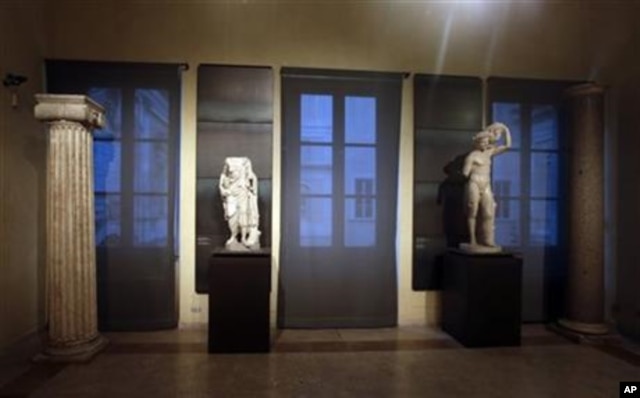Critics Assail Italy for Hiding Nude Statues During Rouhani Visit

Memes are making the rounds mocking Italy’s decision to cover up nude statues at Rome’s Capitoline Museum with big white boxes for a visit by Iranian President Hassan Rouhani.
Ahead of Monday’s press conference between Premier Matteo Renzi and Rouhani, wooden panels were erected around some Roman statues in the museum.
The decision has caused anger in Italy, where it has been condemned by critics as «incomprehensible,» «ridiculous,» and «submission» to principles that are against Western culture.
Some of the marble statues that were covered up with wooden panels on the occasion of Iranian President Hassan Rouhani’s visit are seen at the Capitoline Museums, in Rome, Jan. 26, 2016.
The museum says the Renzi’s office wanted the statues along Rouhani’s path to the press conference covered up. Renzi’s office declined to comment.
When Renzi and Rouhani spoke, it was in a room featuring the famed bronze statue of Emperor Marcus Aurelius, fully clothed.
Speaking on January 27 in Rome, Rouhani said that Tehran had not contacted Italian officials to ask for the statues to be covered up.
«This issue is something journalists and the press like to discuss,» Rouhani said.
«I know that the Italians are very hospitable, a people who seek to make their guests’ visits as pleasant as possible and I thank them for that,» Rouhani added.
Italian Culture Minister Dario Franceschini, who accompanied Rouhani on the museum trip, called the classical cover-up «incomprehensible.»
He insisted that neither Renzi nor himself had been made aware of the decision in advance.
According to some media reports, France has balked at making a similar gesture.
A photoshopped picture of the Mona Lisa wrapped in the Islamic hijab that is compulsory for women in Iran was being shared on social media ahead of the trip, which follows the lifting of sanctions against the Islamic republic under a landmark deal restricting its nuclear program.
Some Iranians have likened Italy’s decision to cover up nude statues to Iran’s state censorship, including tough Internet censorship that targets tens of thousands of websites.
«Smart filtering of statues during #Rouhani’s trip to #Italy,» reads the tweet that includes a photo of the nude statues covered in the page that Iranians see when they try to access banned websites.
In 2013, a relief carving of a naked man at the U.N.’s headquarters in Geneva was covered up by a large white screen apparently in an effort not to offend Iranian diplomats who were due to take part in talks over Iran’s nuclear activities.
More than four centuries ago, the Roman Catholic Church commissioned Daniele da Volterra to paint veils and loincloths over some of Michelangelo’s nudes in the Last Judgment, an 1,800-square-foot panel in the Sistine Chapel.
Da Volterra was scorned by contemporary artists for agreeing to do so.
One papal master of ceremonies at the time is said to have told the pope that the painting was «more fitting for a bathhouse or a tavern than a papal chapel,» Reuters reported.
Radio Free Europe/Radio Liberty contributed to this report.


